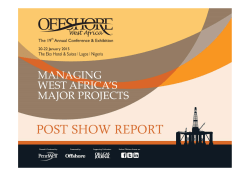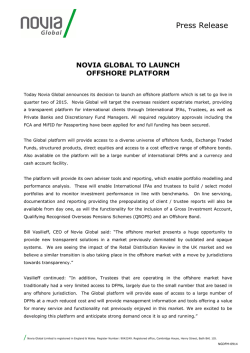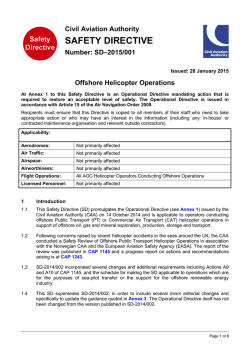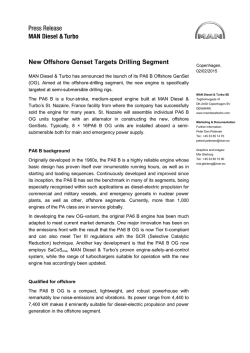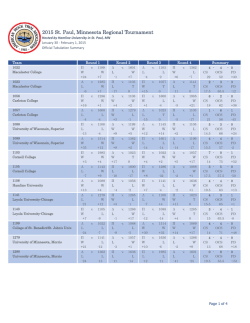
Evaluating the Risks of Offshore Oil Development
.
•
··~
,·.:
· ..
.
.....
...
.
.
. ;:_·
· ..
._
.
·_- .....··..:":.::~-:-~ ·...
.
~1
....
~·
· ..
.-~.:~- ~..._ )~~-~;~··
...........
..
..'•:' ... ·.. -~:~
Evaluating the Risks of
Offshore Oil Development
The increasing world appetite for oil and the recognition of oil as an
important strategic weapon and diplomatic tool has spurred intensive
efforts to develop offshore oil resources. 1 The United States Geologic
Survey estimates that as much as 41 percent of the nation's
undiscovered, recoverable oil lies offshore. (Dalton et al. 1981 ).
Drilling offshore for oil is not new. In 1896 offshore wells were drilled
from wooden piers in California's coastal waters. What is ne,w,
however, is the rapid expansion of offshore leasing activity in all types
of marine environments. Currently, about one thousand new wells are
drilled in the outer continental shelf (OCS) per year. (US National
Research Council 1983). In many areas, especially in frontier areas
such as the North Atlantic and the Alaskan continental shelf, this
increased activity has given rise to concern about a variety of impactsto the environment, to the social and economic stability of coastal
communities and to public health and safety.
Prior to allowing oil exploration and development to occur in a
particular OCS area, consideration is given to the potential impacts of
this activity. Indeed, the National Environmental Policy Act 2 requires
the Department of the Interior (DOl) to prepare an environmental
impact statement prior to the Lease Sale. How the potential impacts
should be considered, however, is a very difficult question to answer.
Identification of the potential impacts is clearly an important first
step. Estimating the probability and magnitude of a particular impact,
a basic risk assessment computation, is another ingredient of an
informed impact assessment.
In the following discussion the potential impacts associated
with oil and gas activities on the OCS are identified and described. The
discussion then focuses on risk assessment to evaluate whether this
methodology might improve OCS impact assessment.
1~00·0~71
.\!I'K'"IIIt'fll Rf"\lt"'-', \' ~- ,\;
S.l.UO I!
1983 l'l::num Publl,h&ng Corporarton
.1--1
·':;·"-
EIA REVIEW
4/3-1
271
·......
·.:J
William L. Lahey is General Counsel for the
Massachusetts Coastal Zone Management Office in
Bqston, Massachusetts. Thomas M. Leschine is
Research Associate Professor at the Institute for
Marine Studies of the University of Washington in
Seattle.
En ..·uonmt'nullmp..ttt
..
· ..
William L. Lahey and Thomas M. Leschine
0195-9~55 ~.1
.
·-'
• ...
·:···
P~tential Impacts Associated with Offshore Oil Development
There are a number of activities which are undertaken during offshore
oil exploration and development which pose risks to the environment.
These activities can be divided into three groups: exploration
activities, offshore production activities and onshore activities (See
Table I).
Table I.
The potential impacts of o££shore oil and gas development
Source
Activily
-
..
Exploration Activities
Seismic surveying • ship traffic
• sound waves
• towing cable
=:
Exploratory drilling • drilling muds
• drilling cuttings
• Island construction
fuel spills
Production Acth·ities
oil discharge
• oil spills
(chronic)
• routine
discharge
Routine platform
discharge
,.
. '· '·····.·-:;.
~..
• sewage
• debris
· Production water
.discharge
• metals
• salinity
• temperature
transportation of
oil
• pipeline
construction
• accidental
spills
.
:{i:·~:;~
Onshore Activities
Construction of
oil facilities
• population
influx
• shoreline
modifications
Adapted from Gilbert 1983
272
·-
_-:· ~~..g ·: ~_:.~:·::.:-\;.. ~ :·
... . . . . '.
·. :-. .·: ·-· .~----~~{:;~~:~I-~~-~~·:
-.~-. ~ !··:~·::~ _.:.~
EIA REVIEW
4/3-4
Potenlial Impacts
• disruption of marine mammal
migration
• disturbance to fisheries
• loss of fishing gear
• turbidity and sedimentation
• creates toxicity and
bioaccumulation
• disruption of terrestrial
environment
• toxicity to water column and
benthic organisms
• lethal and sublethal effects on
seabirds
• decline of tourism
• aesthetic degradation
•
•
•
•
toxicity to benthic organisms
fish kills
reduced species diversity
chronic effects to water column
organisms
• disruption of benthic
environment
• disturbance of shoreline·
• disruption of community
stability
• pressures on local services
• alteration of circulation
patterns, habitat
·"'
'
..
.· ·..
~·.
:·
~--
. '
·.~
.
. .. ~ . : .
.. ·
·,:- .•"
~
:.
-'"
±"e ,:·,
Exploration actzuztzes. The first step in developing oil reserves 1s
locating the most promising hydrocarbon reservoirs. Marine
geophysical surveys and exploratory drilling are the two methods used
to evaluate the oil and gas potential of a marine area. A common
geophysical survey technique is seismic profiling, which involves
producing soundwaves under water so that the reflected waves can be
recorded by hydrophones towed from a ship. The sound waves can
disrupt marine life, especially breeding populations of marine
mammals. In 1966, seismic surveys are said to have caused a fish kill in
Georges Bank off the coast of Massachusetts (Robadue and Tippie
1980).
Seismic surveys, moreover, can directly disrupt commercial
fishing. Hydrophones and cables towed by survey ships have ripped
nets and detached lobster and crab trap markers. The threat of fishing
gear loss has been of special concern in the North Atlantic, off the
coasts of Oregon and Washington and in Alaskan waters. In 1982, for
instance, the State of Washington negotiated an agreement with the
Department of the Interior designed to reduce fishing gear loss by
restricting offshore seismic surveys during peak fishing seasons
(Washington State and US Department of Interior 1982).
Exploratory wells are used to determine the extent of the
offshore hydrocarbon reserves. These operations are generally
conducted from mobile platforms or ships and are usually short-lived
(3-6 months). Exploratory drilling in the Arctic, however, is frequently
conducted from artificial islands constructed from sand and gravel to
prevent damage to the rig from ice movement (US Geological Survey
1981). Constructing these gravel islands poses a significant hazard to
the surrounding marine and terrestrial environment. Inland
extraction of gravel for construction destroys vegetation and increases
erosion. Offshore gravel extraction and the construction of the island
disrupts benthic organisms and may affect higher animals including
whales due to heightened noise and turbidity (US Geological Survey
1981 ). There is a possibility, moreover, that these islands interfere with
the migrations of some marine mammals.
During exploratory drilling two categories of material are
regularly discharged-drilling fluids and drill cuttings.~ The fate and
effects of these discharges in the marine environment have been the
subject of numerous studies and reports 4 and have generated
considerable public debate.
Exploration and production drilling on the OCS is done with
rotary equipment. Rotary drilling involves a rotating drill bit encased
in a hollow drill stem, which contains circulating fluids. The most
important function of the drilling fluid is to remove the crushed rock
cuttings from around the drill bit and transport these cuttings to the
surface for disposal. The drilling fluid performs other essential
functions such as controlling pressure in the well and lubricating the
drilling equipment. Drilling fluids contain a variety of different
substances-from walnut shells to chrome lignosulfonate-according
to the drilling conditions.
El..\ REVIEW
4/3-4
273
.f •
..
-_ f!IW:~ti,lz:tf:'~~ •
~if".:.·.~··.-~~.>~~
~
.·
).c>
-~><~.--·...
.. ·' .
}:~;
::\ ~~-:--~ --~;\
.·
.. _..
....
. ,·
..~
. '
.J
·:.: . .....:
--------------~--~~---~~/:___._··~·:,,.,.,,.,·,-.~--·-.~·r·-·> ,_, .-·~---~._
...
.' .
~·.. :··
Both drill cuttings and drill fluids are regularly discharged
during drilling operations. Cuttings are discharged continuously
while drilling is in progress. The rate of discharge ranges from one to
ten barrels per hour according to factors such as drilling depth. During
the entire life of a well approximately 3000 to 6000 barrels of cuttings
are discharged, not including the cuttings deposited directly on the
ocean floor (US National Research Council 1983). Drilling fluids are
replaced and discarded periodically due to changes in drilling
conditions or because the fluid becomes saturated with cuttings. The
volume of fluid discharged varies widely. Over the lifetime of an
exploratory well, for instance, between 5000 and 30,000 barrels of fluid
will be discharged (US National Research Council 1983 ).
As articulated in the recent National Research Council (NRC)
report on drilling discharges, the two major environmental concerns
associated with these discharges are: (I) the direct effects they may have
on marine organisms and (2) the presence of heavy metals or organic
materials in the discharges which may bioaccumulate in food chains
(US National Research Council 1983).
Drilling discharges can directly disrupt marine organisms,
especially benthic organisms, in a number of ways. Drill cuttings can
accumulate on the ocean bottom thereby smothering the organisms
residing there. Certain additives to the drill fluids, such as chrome
lignosulfonate, can kill marine organisms or cause a variety of
behavioral or physiological problems. (Derby and Atema 1981 ). The
extent to which these discharges will disrupt benthic communities is
largely a function of the amount of material that accumulates on the
substrates, which in turn is related to the dispersive characteristics of
the discharge site. In high energy environments, such as Georges Bank,
fluids and cuttings from exploratory drilling have not accumulated to
any extent nor has the benthic community been affected in any
appreciable way (Battelle Memorial Institute/Woods Hole Oceanographic Institution 1983). In low energy environments, on the other
hand, the accumulation of drilling materials around the drill site has
caused reduced benthic species diversity and abundance due to
smothering or chemical toxicity. For instance, studies of the effects of
drilling discharges on the mid-Atlantic OCS off the coast of New
Jersey, an area with low dispersive characteristics, found that the
diversity and abundance of benthic organisms experienced a
significant decline (US National Research Council 1983).
The other key environmental concern regarding drilling
discharges is the extent to which discharge components, such as
metals, accumulate in marine organisms and threaten organisms up
food chains, including humans. A variety of metals are found in
drilling fluids including chromium, cadmium, barium and lead. The
National Research Council reviewed the recent laboratory and field1
studies on metal accumulation and concluded that the biological
effects are minimal. The NRC review did point out, however, that
there are insufficient studies on the bioaccumulation in marinefood
webs of metals present in drilling fluids.
.·. ·, .
·~
274
·-
.
·...
EIA REVIEW
4/3-4
C'
0
r;
tl
p
0
n
Sl
h
h
fr
tl
d:
0:
n-.
rr
a
e1
e~
t~
rr
Sf
A
;
Oi
i
lf
c<:
c
dJ
0'
01
cc
re
tr:
St·
0
tr;
pt
pi
es
sr:
dt
oc
ag
01
bl
.
~
~·..
...
.
- .~.
-·.
.~"
Offshore production activities. While the offshore well is producing
oil, there are an umber of routine and accidental discharges which pose
risks to the environment. Oil can enter the marine environment
through both chronic low-level releases and sudden large discharges.
Production water is the primary chronic discharge associated with
offshore production. Removing oil and gas from the sea bottom
necessitates removing a large volume of water present in the rock
strata. This water, often referred to as production or formation water,
has a high salinity, contains little or no oxygen and contains
hydrocarbons and toxic metals. The amount of water produced varies
from 20 to 150 percent of the oil output (Gilbert 1983). After passing
through an oil-water separator the production water is usually
discharged. Production water can cause thermal, chemical and
osmotic stress to marine organisms such as plankton (Gilbert 1983).
~letals in the production water, such as barium, chromium and
manganese, may also pose hazards to marine life.
The unintentional, uncontrolled release of oil-a blowout-is
a significant source of both perceived and actual risk to the marine
environment. Major spills are actually quite rare. The blowout rate is
estimated to be less than one for every 500 wells drilled. Only a few of
these blowouts result in major spills. Although the probability of a
major accident is low, the magnitude of damages associated with the
spill is potentially enormous (US National Oceanographic and
Atmospheric Administration 1983). Nevertheless, increases in the level
of offshore oil development can be expected to result in an increased
incidence of oil spills (Stewart and Devanney 1978).
Human error and severe environmental conditions are two
causes of oil spills. The largest oil spill to date, for instance, the
IXTOC I blowout, was caused by an error in judgment in changing a
drill bit (Ross et al. 1979). In June 1979 this exploratory well spilled
over 450,000 tons of oil off the coast of Campeche, Mexico.
Geological hazards also increase the risk of spills. Rigs placed
on steep slopes are subject to damage from unstable sea floor
conditions. Earthquakes can also cause damage to offshore structures
resulting in an oil spill (Gilbert 1983 ). Although no oil was spilled, the
tragic loss of the drilling platform Ocean Ranger and its crew in a
storm off Nova Scotia in 1982 exemplifies the threat posed by storms.
Oil is transported to shore either via pipeline or by tanker. Ship
transportation from offshore fields or refineries accounts for the largest
portion of spilled oil in the entire exploration and development
process. A 1975 study by the National Academy of Science (NAS)
estimated spill that transportation accidents account for a volume of
spilled oil four times greater than the amount released by accidents
during offshore production. One of the most spectacular accidents
occurred in March 1979 when the supertanker Amoco Cadiz ran
aground off the coast of Brittany, France spilling some 220,000 tons of
oil. This spill was roughly twenty times the size of the Santa Barbara
blowout spill in 1969 (US National Oceanographic and Atmospheric
EIA REVIEW
4/3-4
275
.. .
·::-
. ;$~tff
-_
'
-~·-'
.
-- ,..
.. -..
-~
.
... -· . _._,..
.;,.-~-·
·~
.
·_
:
..
,·.
...
·.· .. ::~·:_ ~·~
: : .....:.:. ~: -~r~- ;.
...
-~~- ~
.;
::;.
;-.; -:--··.'
... .=·.·:.
... _,_
:.:. :~ ..
.....L'~~~:'~t~~~i~.
·.
.·
.
..
:--
.
. .-
. ...... )~~
Administration 1983). Spills from an oil pipeline can arise from a
number of sources such as erosion, seabed instability and fishing
snags.
Pipeline and other types of construction related to oil
production can also disrupt the marine and nearshore environments.
The sea floor is often disrupted by dredging relating to laying
underwater pipelines. The location and manner in which the
underwater pipes are brought to shore can cause environmental harm,
especially in estuaries where dredging and filling can alter drainage
patterns and increase erosi.on. In the Arctic, offshore terminals will be
necessary to accommodate deep draft tankers because Arctic nearshore
waters are quite shallow. These offshore terminals may be disruptive to
whales during migration or summer feeding.
Onshore production-related activities. Onshore activities in support of
drilling and exploration offshore can be the source of benefits as well as
environmental, social and economic costs to coastal communities. The
number and nature of required onshore facilities are directly related to
the level of offshore activity·. During exploration a temporary service
base is usually the only industrial facility necessary. If no
commercially exploitable quantities of oil are found, no other facilities
need be built. However, a number of onshore facilities are necessary for
production, including service faCilities for shipping equipment and
personnel to offshore sites, facilities for the repair and maintenance of
vessels and for the installation of pipelines, processing complexes to
separate the oil, gas and impurities, and shipping facilities.
Large amounts of land and water may be necessary to support
the construction and operation of such facilities, and competitioq for
scarce harbor space may work to the detriment of such traditional
activities as commercial fishing. The support facilities, moreover, may
require a variety of improvements or additions to existing
transportation systems.
Offshore oil production, especially in frontier areas, often
necessitates the influx of a large labor force. On the North Slope of
Alaska, for instance, the non-native population quintupled between
1970 and 1979 as a result of offshore oil activites (US Geological Survey
1981). This population influx can overwhelm schools, available
housing and the infrastructure throughout the host community. In
some instances in Alaska these developments caused major shifts in the
community social structure by shifting the local economy from a
subsistence to a cash economy.
...":...
The Effect on Resources
A wide variety of marine and coastal resources are at risk as a result of
offshore oil development. These include such ecological resources as
benthic communities and sea birds and such social resources as the
tourist industry and the continued integrity of coastal communities.
Marine habitats and organisms vary widely in· their
276
EIA REVIEW
4/3-4
\'ulnerability w damage by spilled oil. In a recem review of the
ecological effects of oil spills, Teal and Howanh (1984) summarized
studies of oil spills conducted since the 1975 N AS repon, including
spills from platform Bravo in the North Sea and IXTOC I. These
studies show that petroleum hydrocarbons can reach subtidal marine
sediments and remain in the water column in concentrations great
enough w affect the bemhic and planktonic communities. Under some
conditions, long-term effects can occur in benthic communities,
especially in soft sediments in shallow protected waters. In addition,
rates of weathering and detoxification of oil are now known to be
highly variable. In some cases rates of recovery have been much slower
than previously believed, in others, recovery has been relatively rapid
and damage minimal. Table 2 indicates the range of vulnerability for
intenidal communities.
Teal and Howarth emphasized that even the "best" studies of
oil spills in the environment are extremely limited in their scope and
that natural variability makes firm conclusions very difficult. This
review indicates that for some communities, especially planktonic, the
complexity of this system makes research so difficult that it is unlikely
that all effects of oil will ever be detected. They emphasize, however,
that this does not mean the effects are not occurring.
There are a number of ways that benthic organisms can be
affected during offshore oil development. Some fractions of spilled oil
have been shown to be acutely toxic to certain benthic organisms
(Nunes and Benville 1978). Hydrocarbons tend to accumulate in the
sediment and become a source of chronic exposure for marine.
organisms living there. Some hydrocarbon derivatives, such as the
metabolic intermediates of polynuclear aromatic hydrocarbons are
highly carcinogenic, mutagenic or teratogenic (Menzie 1982). Reduced
abundance and species diversity of benthic organisms has been
observed around production platforms (Menzie 1982). As discussed
earlier these impacts are caused by the discharge of drilling fluids and
cuttings.
Benthic organisms are of concern in OCS risk assessment and
impact studies for several reasons. First, many of the most valuable
commercial fishery resources of the continema1 shelf are epibenthic
organisms. These include such species as scallops, razor clams and
Dungeness, king and Tanner crabs in Alaskan waters; lobsters,
scallops, surf clams and ocean quahogs in the Nonh and Mid-Atlantic;
and abalones, corals and spiny lobsters in Southern California.
Second, benthic infaunal organisms, such as polychaete worms and
amphipods, are an important food source for demersal fish and
California gray whales. Third, since benthic organisms are relatively
stationary and include many suspension and deposit feeders, they are
particularly sensitive to pollutants in sediments and in the sedimentwater interface. Many benthic organisms have a propensity to
accumulate toxins in their tissues, thus making them critical links in
pathways with the potential to pass toxicants on to humans.
EIA REVIEW
4/3-4
277
.,.~·....
¥.~:~---. ~-+
..... .....
.. .
~·.
~
..·'·
./
..
·o<;
•••
~;:.~~r-:~.
.
..
~
~
':
·-~--
.. ; ~- ....
1;;-.- .-:.··. ':'.~-· ~ ..
;: :. ·' ~~
~--.
,.. ....
'<J . . -
_.J~·:.~·-:
-.
. . __
~
. .,..
... '·'·
~-
.,. . ·--- . . --- .......
~,··:·~#
. .:_"":"·.
278
.......
EIA REVIEW
4/3-4
....
Organisms in the water column, such as phytoplankton,
zooplankton and fish eggs, can be seriously affected by spilled oil and
other discharges. Studies suggest that spilled oil can cause significant
demersal fish egg mortality (Hufford 1971 et al. 1971) Generally, larval
stages of various organisms ar 10 to 100 times more-sensitive toward
spilled oil than adults (Moore et al. 1974).
In addition, there may be indirect effects that are more difficult
to document. In one case, the 1977 Tsesis spill in the Baltic Sea, the
hatching success of herring eggs was 29.5 percent lower in the oilaffected area studied than at control sites. While direct oil
contamination of the eggs was a possible cause, it was more probable
that an oil-induced kill of gammarid amphipods was at fault. These
benthic crustaceans are known to graze on the fungi which infect
herring eggs, thus keeping the eggs clean and the hatching success
relatively high (Nellbring et al. 1980).
Coastal habitats, such as tidal flats, marshes and estuaries, are
important breeding, nursery and feeding grounds for finfish, shellfish
and shore birds. Marshes and estuaries also serve as sediment and
nutrient traps, storm barriers and aquifer recharge areas. These
resources and functions can be seriously degraded by oil development
activities. A long term study of an oil spill in an estuarine area of
Massachusetts, for instance, found that it caused very significant longterm ecological changes (Sanders et al. 1980). Dredge and fill
operations associated with pipeline and onshore facility construction
can also pose a major threat to coastal resources. The Council on
Environmental Quality determined that dredge and fill activities in the
Gulf of Mexico associated with pipeline construction caused more
damage to wetlands than did oil pollution (US Council on
Environmental Quality 1974).
Marine mammals are an integral biological resource which
have significant social and cultural value. Bowhead whales, for
instance, are an important subsistence resource to Arctic natives.
Whales and other marine mammals may be adversely affected by oil
development in a number of ways. Discharges may diminish food
supplies by degrading the quality and quantity of water column
organisms. Increased activity and noise from ships, aircraft, seismic
surveys and gravel islands may cause 1) pronounced short-term
changes in behavior, 2) temporary displacement of whales and
pinnipeds on land, and 3) limited disruption of acoustic
communication. For the most part long-term effects and the biological
significance of both long and short-term impacts are not known,
although some pinniped deaths from stampeding have occurred from
low air flights over haul-out sites where they are most easily disrupted
during the breeding and pupping season (Richardson et al.l983).
The direct impacts of spilled oil on cetaceans are very poorly
understood, but the few observed effects have appeared to be minor or
short-lived. Hair seals and walruses, which, like whales, depend on
EIA REVIEW
4/3-4
279
'-~
1?~-,~::·
..
~-·
~
t· -_. -: ~:-.~- ·. _.~.~.:~
->t·
-· . . . -
-:_, . '...... :;. . .
~
·!. : ..
·:'~1\i.\*:~{~~_;:~· :._ -·
1~-·:·
......·.:.
. -.
\'y. --:
.·
·.··.
.. .
~
'".:·
.
blubber for thermoregulation, appear to suffer few serious effects from
light to medium contact with oil unless under additional stress or of
sub-adult age. In contrast, fur seals, sea lions, sea otters and polar bears
are all especially vulnerable to being oiled since their fur can become
matted, resulting in loss of heat and ingestion of oil during attempted
cleaning (Richardson et al. 1983 ).
Pelagic and marine birds are especially intolerant of oil
pollution. The oil damages the waterproofing and insulating ·
properties of the feathers thus increasing the susceptibility to
hypothermia and pneumonia and reducing the ability to feed or fly
(Vermeer and Vermeer 1975). Seabirds, like many marine mammals,
are particularly vulnerable to large spills during their breeding
seasons. There is also concern about the sublethal effects from both
large spills and chronic pollution on birds living under natural or
human-induced stress, particularly in the Arctic (Levy 1983).
Fishery resources, both finfish and shellfish, are jeopardized by
offshore oil production in a variety of ways. Spilled oil can cause a
significant loss of eggs and juveniles thorugh both lethal and sublethal
biochemical toxification. Sublethal effects on adults can lead to
reduced reproductive success and lowered survivorship among larvae
and juveniles. After the IXTOC I Spill, for example, the harvest of
Campeche shrimp within Mexico reportedly decreased by 50 percent
(Caron 1983). Oil development may also hamper the fishermen
themselves because of loss of fishing grounds to drilling platforms, oil
tanker tran'Sit and pipelines. Lit.tering the ocean floor with unwanted
material dumped from platforms can result in significant gear loss
(Grant 1978).
Diminished fish catches, such as a reported decline in fish catch
per unit effort in the Gulf of Mexico, are notoriously difficult to link to
offshore activity. Nevertheless, some scientists point to the destruction
of marshland for oil barge canals as the primary reason for the fishery
decline in the Gulf {jackson 1981).
Under some conditions offshore oil development may cause a
public health hazard. A blowout off the coast of Nigeria in 1980
polluted the Niger Delta and ruined drinking water and food supplies
(Caron 1983).
The social and environmental integrity of the host coastal
communities is another resource which may be at risk from
development associated with offshore oil. Onshore construction of
facilities for oil development as well as increased construction of roads,
and other infrastructure to accommodate the population influx could
degraqe some environmental amenities of the host community.
The economy of the host community may also be subject to
destabilizing growth patterns. In the "boom-bust cycle," rapid
economic development and large influxes of outsiders can alter the
social and cultural condition of a community, especially communities
in the Arctic which are based on a subsistence economy. Some of the
280
···:
EIA REVIEW
4/3-4
socicn'
drug
movi1
comrr
comrr
econo ·
1ncorr
point.
coastz
coast
Franc
study
the ;-..
estim<
visit 1
transL
dollar
ocs l
Not a.
1ncrea
specie
risks
maker
en virc
identi.
assess1
surrot
into fc
and ri
ment,
assess I
variou
affecte
what c
and g
interp
sets o
catasn
some 1
thougl
subjec;
subjec;
mcorp
undert
,.
social and cultural effects are: increased incidence of alcoholism and
drug abuse, the emergence of social stratification in communities
moving from a subsistence economy to a cash economy and loss of
community cohesion. However it must also be pointed out that many
communities or groups of actors within them stand to benefit
economically from OCS development. The very high per capita
income in Alaska as a result of Prudoe Bay development is a case in
point.
Oil and gas development may also have an adverse affect on the
coastal tourist industry. For instance, the Amoco Cadiz oil spill off the
coast of Brittany, one of the most popular summer vacation areas in
France, caused a significant reduction in tourism. A comprehensive
slUdy of the social costs resulting from this spill recently completed by
the National Oceanic and Atmospheric Administration (NOAA)
estimated that approximately 245 thousand tourists did not come to
visit Brittany in 1978 because of the spill. This decline in tourism
translated into estimated economic losses of between 28 and 60 million
dollars (US National Oceanic and Atmospheric Administration I 983 ).
OCS Risk Assessment
Not all risks are equal. Indeed, it is difficult to compare the risk of
increased alcoholism among native Alaskans and the risk of decreased
species diversity in marine benthic communities. Yet both types of
risks should be considered by offshore oil development decision
makers. How should such risks be considered and balanced? The OCS
environmental impact assessment process has, to date, emphasized the
identification of hazards and the estimation of impacts rather than the
assessment of risk per se. The nature of many controversies
surrounding OCS development in frontier areas has, however, brought
into focus a need to consider further the possibilities of risk assessment
and risk management strategies.
When discussing the risks associated with offshore development, it is important to consider how risks are estimated in formal
assessments. Decision makers weighing the relative importance of
various types of risk often find, however, that the perceptions held by
affected parties of the seriousness of some risks differ significant! y from
what quantitive assessments may indicate. The judgments individuals
and groups make about risk may depend on personal biases and
interpretations of consequence made with reference to highly personal
sets of beliefs (Thomas 1981). For example, the possibility of
catastrophic effects, however remote, appears to profoundly influence
some people's attitudes and actions. Quanitititative risk assessments,
though seemingly more objective, may also depend on a variety of
subjective judgments on the part of the _analyst. Most often this
subjectivity is introduced because there is more than one way to
incorporate technical information into the assessment (Smalley I 980).
To assess quantitatively the risk posed by a hazardous
undertaking, a two-part computation is required. First, since it is not
EIA REVIEW
4/3-4
281
.,
.;~
,.
.....
~
···---·.:.··.:::
).,
.
..... !
••
.
·~
.
.
·_::
·-:' ~.
. _:..,-:._·:i)-,:~·~:··. ~-
•\:•
· ..... :
.__ .
.;.
~-
··.....
..
-:. ..
.
- ..
. ·:·
;,_.-: ·-. ~:·:
.·· :.;.·..... . ::·
certain that calamity will occur, the probability of occurrence must be
estimated. Second, even if catastrophe does occur it is not certain how
great the damages will be. Thus the likely impacts must also be
estimated. Ideally, "the expected value" of the risk is then the product
of these two estimates (Smalley 1980). When probabilities are
conditional, such as when a so-called fault-tree analysis is performed, a
complex calculus of probabilities must also be brought into play. The
problem of estimating impacts and probabilities is further
complicated by the fact that we have little experience with activities
such as offshore development in harsh environments, leaving little
empirical evidence upon which to base analysis.
Ultimately, the question of the "acceptability" of the risks
associated with offshore development is one phrased best in terms of
the acceptability of particular development alternatives with
particular sets of risks, costs and benefits associated with them (Derby
and Keeney 1981). There is much evidence to suggest that real human
decisions about risky enterprises are seldom made without at least
implicit reference to the benefit side of the risk-benefit equation. Thus
it is not surprising that wide disagreements exist over the
appropriateness of present offshore development policies, and that
development strategies deemed acceptable in one OCS region may find
little acceptance in another (See e.g. Pagan 1980).
Risk assessments in the strict sense have been conducted for a
number of years by the US Geological Survey(USGS) for pending OCS
lease sales\ The USGS Oil Spill Trajectory Model (Lanfear et al. 1979)
has been used to assess the probabilities and likely trajectories of spills
with respect to vulnerable resources in proposed OCS lease sales. Still,
the role of such assessments in leasing decisions remains unclear (see
Stedman in this issue).
The use and interpretation of risk assessments has several times
become involved in OCS ligitation. In the mid 1970's assessments
conducted for Long Island commumt1es became persuasive
bargaining instruments in disputes with the Department of Interior
over leasing in the North and Mid-Atlantic(Koppelman and Robbins
1980). More recently, the issuance by the Environmental Protection
Agency (EPA) of permits for the construction and operation of the
Pittston refinery in Eastport, Maine was voided pending additional
quantitative analysis of the probability of tanker spills in channels
near the refinery site (Roosevelt Campobello International Park
Commission v. EPA, 17 ERC 2023). In a recent Alaskan case, however,
the federal circuit court declined to require DOl to conduct extensive
quantitative assessments of oil spill risks at the pre-lease sale stage
(Village of False Pass v. Watt, 18 ERC 2129 and 20 ERC 1705 ).
It is clear that many potential serious impacts do not lead
themselves to formal risk assessments, even though quantitative
assessments have proved useful where appropriate. Considerations of
282
EIA REVIEW
4/3-4
risk~·
way
mar:
sche
com
Nev.
Sma
lnCr<
way
redu
RisF.
redu
Imp
In e~
the
mea:
be dt
over
and
agen
and
proc
mea~
man
spor
mad
:\ton
Atla:
proc
stan<
redu.
The
. Coas
mon
they
prOC<
oil <
en de:
cann
em·ir
quan
with
the a
howt
. ......
~
.:
. . . . . . . . ··-·.: j
:-
~
....
~-
.-.
•'
. ·.
·... .
. , ........"'
~
~
-
~~2
\~f.·-:;.
-~
risks can be incorporated into OCS oil and gas decisions in a number of
ways (Smalley 1980). Improved assessment capabilities can improve
management decisions, but simple "automated" decision-making
schemes are unlikely to replace the complex interplay among
competing interests which now typifies OCS leasing decisions.
Nevertheless, the purely informal approach to questions of risk, which
Smalley equates with the make-it-as-safe-as-possible approach, is
increasingly difficult to justify, because it fails to provide any direct
way to compare the reduction in risk achieved to the costs of risk
reduction.
Risk Management. Risk reduction, which can work either by impact
reduction or by reduction of the probabilities of misfortune, is an
important tool of risk management. Efforts to reduce the uncertainties
in estimates of the magnitude of potential impacts, or in estimates of
the probabilities of accidents, have proved costly and difficult. Yet
measures to reduce risks, or to compensate those who must bear it, can
be developed fairly easily. Such measures often emerge from the debate
over OCS leasing decisions, whether in the courts or through formal
and informal bargaining among federal agencies, between federal
agencies and the states, or among other affected interests (See Charter,
and Hirsch and Scott, in this issue). OCS leasing and development has
proceeded, albeit at a slower rate than many would like, in large
measure because such bargains have been struck.
The OCS regulatory program has incorporated a variety of risk
management measures. The Environmental Studies Program
sponsored by the Bureau of Land Management has in many instances·
made the prediction of impacts a much more tractable problem.
Monitoring programs like those developed for the North and MidAtlantic and Eastern Gulf of Mexico have allowed exploration to
proceed in the face of uncertainties about potential impacts. Improved
standards for tanker and pipeline construction and operation have
reduced the risk of accidents which release oil into the environment.
The Coastal Energy Impact Program, administered under NOAA's
Coastal Zone Management Program, has made offshore development
more palatable by compensating communities for some of the costs
they bear in supporting onshore activities.
In total, measures like these, if they allow OCS development to
proceed, constitute a rough measure of societal willingness to pay for
oil development offshore. As in other technologically intensive
endeavors, risk cannot be reduced to zero and deleterious impacts
cannot be eliminated. At the same time, public apprehensions about
environmental harm cannot be judged "wrong" when they differ from
quantitative assessments of risk. Such perceptions can and do change
with the contextual framework in which judgments are made about
the acceptability of activities like OCS development. Unavoidably,
however, OCS development carries risks a_nd costs as well as benefits.
EIA REVIEW
4/3-4
283
·~
..
·-
~·- ·~·
t~
t -~. .
'
..:
Acknowledgments
This manuscript was prepared while both authors were affiliated with
the Marine Poilicy and Ocean :Vlanagement Program at Woods Hole
Oceanographic Institution, with support from the Pew Memorial
Trust and the Department of Commerce Office of Sea Grant under
grant 80AA-D-000-7i(R/B-43).
Notes
1. "Offshore" refers to both state and federal submerged lands; "OCS"
refers to federal lands only, in other words, lands between the state's
offshore boundry, typically three miles offshore, and the limits of
US jurisdiction.
2. 45 ucs §4321-70 (1969)
3. Drilling fluid is also commonly referred to as drilling mud.
4. There are a number of comprehensive, and in some cases, critical
reviews of the articles and reports on the fate and effects of drilling
discharges:
• National Research Council. 1983. Drilling Discharges in the
Marine Environment. Washington, DC: US National Research
Council.
• IMCO Services. 1982. Environmental Aspects of Drilling Fluids: A
Biography. 3d Ed. Technical Bulletin. Houston, Texas: IMCO
Servic~s.
• Petrazzuolo, G. 1981. Preliminary Report: An Environmental
Assessment of Drilling Fluids and Cuttings Released onto the
OCS. Washington, DC: Environmental Protection Agency .
.
. •...
References
Baker, J.M. 1983. Impact of Oil Pollutimz on Lh•ing Resources.
Commission on Ecology Papers :\'umber 4. (Supplement 4 of
The EnFironmenta/ist). !\-forges. Switzerland: International
. Union for Consen·ation of Nature and Natural Resources.
':!
Bauelle :\lemorial Institute'Woods Hole Oceanographic
Institution. 1983. (;eorgf's Bank Bf'nthic lnfazma Monitoring
l'rogram. Final rf'port, }'f'ar 1. Washington. DC: US
Department of Interior.
Caron. D.O. 1983. Liability for Transnational Pollution Arising
from Offshore Oil Dndoprnmt: A :\kthodologir.Jl Approach.
Ecology Law Quarterly I 0:6-ll-6H3.
Dalton G.L., Carlson, K.H., Charpentier, R.R., Coury, A.B.
1981. Estimates of Undiscovered Recoverab{e Resources of
Conventionally Producible Oil and Gas in the US. Circular
860. Washington, DC: US Department of Interior, Geological
Survey.
284
EIA REVIEW
4/3-4
).
~-'
Derby, C.D. and Atema, J. 1981. Influence of Drilling Fluids on
the Primary Chemosensory Neurons in Walking Legs of the
Lobster, Homarus americanus. Canadian journal of
Fisheries and Aquatic Science 38:268-274.
Derby, S.L. and R.L. Ket'ney. 1981. Risk Analysis: Undemanding
'How Safe Is Safe Enough?' Risk Analysis 1,3:217-224.
-;}'1~~~~\
-
- ..
-··; ~-·
-.
... ~ ..
~--
Gilbert, J.T .. ed. 1983. Technical Environmental Guidelines for
Offshore Oil and Gas Development. Tulsa, Oklahoma:
Pennwell Books.
~\.·.
....
Grant, J.P. 1978. The Conflict Between the Fishing and Oil
Industries in the North Sea: A Case Study. Ocean
Management -1:137-1-19.
3"
t,-.
.·
;_
-·
.
;-
t·-
,.
Gundlach, E.R. and Hayes, M.O. 1978. Vulnerability of Coastal
Environments to Oil Spill Impacts. Marine Technology
Society journal 12:18-27.
Hufford, G.L. 1971. The Biological Response to Oil in the Marine
Environment. Project 71HI/003. Report. Washington, DC:
US Coast Guard
Jackson, T.C., ed. 1981. Coast Alert: Scientists Speak Out. Sari
Francisco: Friends of the Earth.
Koppleman, Land Robbins, S. 1980. The Long Island Response to
the Risks of Outer Continental Shelf Oil Production. Coastal
Zone Management jouma17.2--l:l63-183.
Kunreuther. H., Lathrop, j.W. 1981. Siting Hazardous Waste
Facilities: Lessons from LNG. Risk Analysis l.-l:289-302.
Lanfear, K.j., Smith, R.A .. and Slack, JR. 1981. An Introduction
to the Oil Spill Risk Analysis Model. Proceedings of the Ele;:enth
Annual Offshore Technology Conference: 2173-2180.
Levy, E.~l. 1983. Commentary: What Impact Will the Oil Industry
Have on Seabirds in the Canadian Arctic? Arctic 36,1:1-4.
Menzie. C.A. 1982. The Environmental Implications of Offshore Oil
and Gas Acti\;ties. Em•ironmental Science and Technology
16:-l54A- -li2A.
Moore. S.F., Chirlin, G.R., Puccia, Cj., and Schrader, B.P.
197-l. Potential Biological Effects of Hypothetical Oil Discharges
in (sic) the .-ltlarztic Coast and Gulf of Alaska. Report No. ~IITSG
7-l-19. Cambridge, ~lassachusetts: :\UT Press.
Nellbring, S.S., .-\ncer Hansson, G. and Weston. L. 1980. Impact
of Oil on Local Fish Fauna. in: Kinernan, ].].. Elmgren, R. and
Hansson. S., eds. 1980. The Tsesis Oil Spill. Washington, DC: l'S
Department of Commerce, National Oceanic and .-\tmospheric
.-\dministration.
:'1/unes, P. and Bem·ille, P.E. 1978. Acute Toxicity of Water-Soluble
Fr.1ction of Cook Inlet Crude Oil to the Manila Clam. Marine
Pollution Bulletin 9:324-331.
Pagan, L. 1980. OCS Development: A Community's Acceptance of
Risks. Coastal Zone .\lanagement journal 7,2-4:223-236.
Richardson. W.j., Gret'ne C.R .. Hickie, J.D. and Davis, R.A. 1983.
Effects of Offshore Petroleum Operations on Cold Water .\Iarine
.\lammnls. .-1 Literature Re7.•ieu.J. Washington, DC: American
Petroleum Institute, Environmental Affairs Department.
EIA REVIEW
413-4
285
/!':··'-- ~. ~ . . . .__ ~_,,.._,..~~~.:....t..""f7~'... ~,..::...-'!'..
.
,
-
-
Robadue, D.D. and Tippie, V.K. 1980. Public Tnmlvemmt
in Offshore Oil De\·eloprnent Lessons from :"\ew England.
Coastal Zone Management joumal i, 2--1:237-269.
Ross, 1979. IXTOC I Blowout. Spill Technology ;\'elL'sletter 4:245.
Sanders, H.L., Gmssle, G.R., :\·lorse, L.S., Garner-Price, S. and
jones, C. C. 1980. Anatomy of an Oil Spill: Long-Term Effects
from the Grounding of a Barge FLORIDA of£ West
Falmouth, MA. journal of Marine Research 38:265-380.
Expan(
·offshoi
and the
Smalley, R.D. 1980. Risk Assessment: An Introduction and Critique.
Coastal Zone Management ]oumal7,2-4:133-162.
Stewart, R.J. and J.W. Devanney. 19i8. Oil Spills and Offshore
Drilling (letter). Science 199,4325:125, 127-128.
Teal, J.M. and Howarth, R.W. 1984. Oil Spill Studies: A Review of
Ecological Effects. Environmental Management 8, I :2i -44.
Thomas, K. 1981. Comparative Risk Perception; How the Public
Perceives the Risks and Benefits of Energy Systems. Proceedings of
the Royal Society of London A3i6:35-50.
US Council on Environmental Quality. 1974. Em•ironmental
Quality- J9i-1. Washington, DC Governmem Printing Office.
US Geological Survey. 1981. Arctic Summary Report. Open-File
Report. Washington, DC: US Department of Interior, Geological
Survey.
US National Academy of Sciences. 1975. Petroleum in the Marine
Environment. Washington, DC US National Academy of
Sciences.
US National Oceanic and Atmospheric Administration. 1983.
Assessing the Social Costs of Oil Spills: The Amico Cadi:. Case
Study. Washington, DC US Department of Commerce, National
Oceanic and Atmospheric Administration.
US National Research Council. 1983. Drilling Discharges in the
Marine Environment. Washington, DC :\'ational Academy of
Sciences Press.
Vermeer, K. and Vermeer, R. 19i5. Oil Threat to Birds on
the Canadian West Coast. The Canadian Field i\"aturalist
89,3:378-298.
Washington State and US Department of Interior,
Memorandum of Agreement. (Signed June I, 1982).
286
EIA REVIEW
4/3-4
1982.
On January 27, 1
Barbara, Calif01
Ocean over asp;;
of the environn
petroleum on th
the blowout gal'
in the United ~
National Enviro
General Accoun
Signed ir
precipitated
\·ast
.
.
In envuonment<::
half. Surprising
Barbara spill, th
EIA on offshore
The pasr
particularly imp
policy m~king i
continental shelf
Interior (DOl)has implemente•
accelerated" It
"streamlined" le
Sale Schedule E1
the Supreme Cr
Coastal Zone /
legislation is bei
certain frontier
valuable for fishi
[n\·ironm~nr.al Impact A, .. t',,r
Ol95-92;.vs3 I200·0~>i7 s~.oo
: 1983 Plenum Publi .. hing Co:
© Copyright 2025

